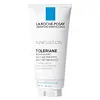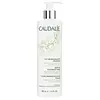What's inside
What's inside
 Key Ingredients
Key Ingredients

 Benefits
Benefits

 Concerns
Concerns

 Ingredients Side-by-side
Ingredients Side-by-side

Water
Skin ConditioningCetearyl Isononanoate
EmollientButylene Glycol
HumectantGlycerin
HumectantCetyl Alcohol
EmollientPrunus Amygdalus Dulcis Oil
Skin ConditioningSimmondsia Chinensis Seed Oil
EmollientSodium Cocoyl Glutamate
CleansingDecyl Glucoside
CleansingButyrospermum Parkii Butter Extract
Skin ConditioningMaltodextrin
AbsorbentCarbomer
Emulsion StabilisingPotassium Cetyl Phosphate
EmulsifyingCaprylyl Glycol
EmollientHydrolyzed Vegetable Protein
Skin ConditioningAcrylates/C10-30 Alkyl Acrylate Crosspolymer
Emulsion StabilisingPotassium Sorbate
PreservativeSodium Hydroxide
BufferingTrehalose
HumectantTocopherol
AntioxidantParfum
MaskingAvena Sativa Kernel Extract
AbrasiveCentaurea Cyanus Flower Extract
AstringentPalmitoyl Grape Seed Extract
Skin ConditioningHexyl Cinnamal
PerfumingLinalool
PerfumingLimonene
PerfumingPlant Ash
Water, Cetearyl Isononanoate, Butylene Glycol, Glycerin, Cetyl Alcohol, Prunus Amygdalus Dulcis Oil, Simmondsia Chinensis Seed Oil, Sodium Cocoyl Glutamate, Decyl Glucoside, Butyrospermum Parkii Butter Extract, Maltodextrin, Carbomer, Potassium Cetyl Phosphate, Caprylyl Glycol, Hydrolyzed Vegetable Protein, Acrylates/C10-30 Alkyl Acrylate Crosspolymer, Potassium Sorbate, Sodium Hydroxide, Trehalose, Tocopherol, Parfum, Avena Sativa Kernel Extract, Centaurea Cyanus Flower Extract, Palmitoyl Grape Seed Extract, Hexyl Cinnamal, Linalool, Limonene, Plant Ash
 Reviews
Reviews

Ingredients Explained
These ingredients are found in both products.
Ingredients higher up in an ingredient list are typically present in a larger amount.
Caprylyl Glycol is a humectant and emollient, meaning it attracts and preserves moisture.
It is a common ingredient in many products, especially those designed to hydrate skin. The primary benefits are retaining moisture, skin softening, and promoting a healthy skin barrier.
Though Caprylyl Glycol is an alcohol derived from fatty acids, it is not the kind that can dry out skin.
This ingredient is also used as a preservative to extend the life of products. It has slight antimicrobial properties.
Learn more about Caprylyl GlycolGlycerin is already naturally found in your skin. It helps moisturize and protect your skin.
A study from 2016 found glycerin to be more effective as a humectant than AHAs and hyaluronic acid.
As a humectant, it helps the skin stay hydrated by pulling moisture to your skin. The low molecular weight of glycerin allows it to pull moisture into the deeper layers of your skin.
Hydrated skin improves your skin barrier; Your skin barrier helps protect against irritants and bacteria.
Glycerin has also been found to have antimicrobial and antiviral properties. Due to these properties, glycerin is often used in wound and burn treatments.
In cosmetics, glycerin is usually derived from plants such as soybean or palm. However, it can also be sourced from animals, such as tallow or animal fat.
This ingredient is organic, colorless, odorless, and non-toxic.
Glycerin is the name for this ingredient in American English. British English uses Glycerol/Glycerine.
Learn more about GlycerinTocopherol (also known as Vitamin E) is a common antioxidant used to help protect the skin from free-radicals and strengthen the skin barrier. It's also fat soluble - this means our skin is great at absorbing it.
Vitamin E also helps keep your natural skin lipids healthy. Your lipid skin barrier naturally consists of lipids, ceramides, and fatty acids. Vitamin E offers extra protection for your skin’s lipid barrier, keeping your skin healthy and nourished.
Another benefit is a bit of UV protection. Vitamin E helps reduce the damage caused by UVB rays. (It should not replace your sunscreen). Combining it with Vitamin C can decrease sunburned cells and hyperpigmentation after UV exposure.
You might have noticed Vitamin E + C often paired together. This is because it is great at stabilizing Vitamin C. Using the two together helps increase the effectiveness of both ingredients.
There are often claims that Vitamin E can reduce/prevent scarring, but these claims haven't been confirmed by scientific research.
Learn more about TocopherolWater. It's the most common cosmetic ingredient of all. You'll usually see it at the top of ingredient lists, meaning that it makes up the largest part of the product.
So why is it so popular? Water most often acts as a solvent - this means that it helps dissolve other ingredients into the formulation.
You'll also recognize water as that liquid we all need to stay alive. If you see this, drink a glass of water. Stay hydrated!
Learn more about Water